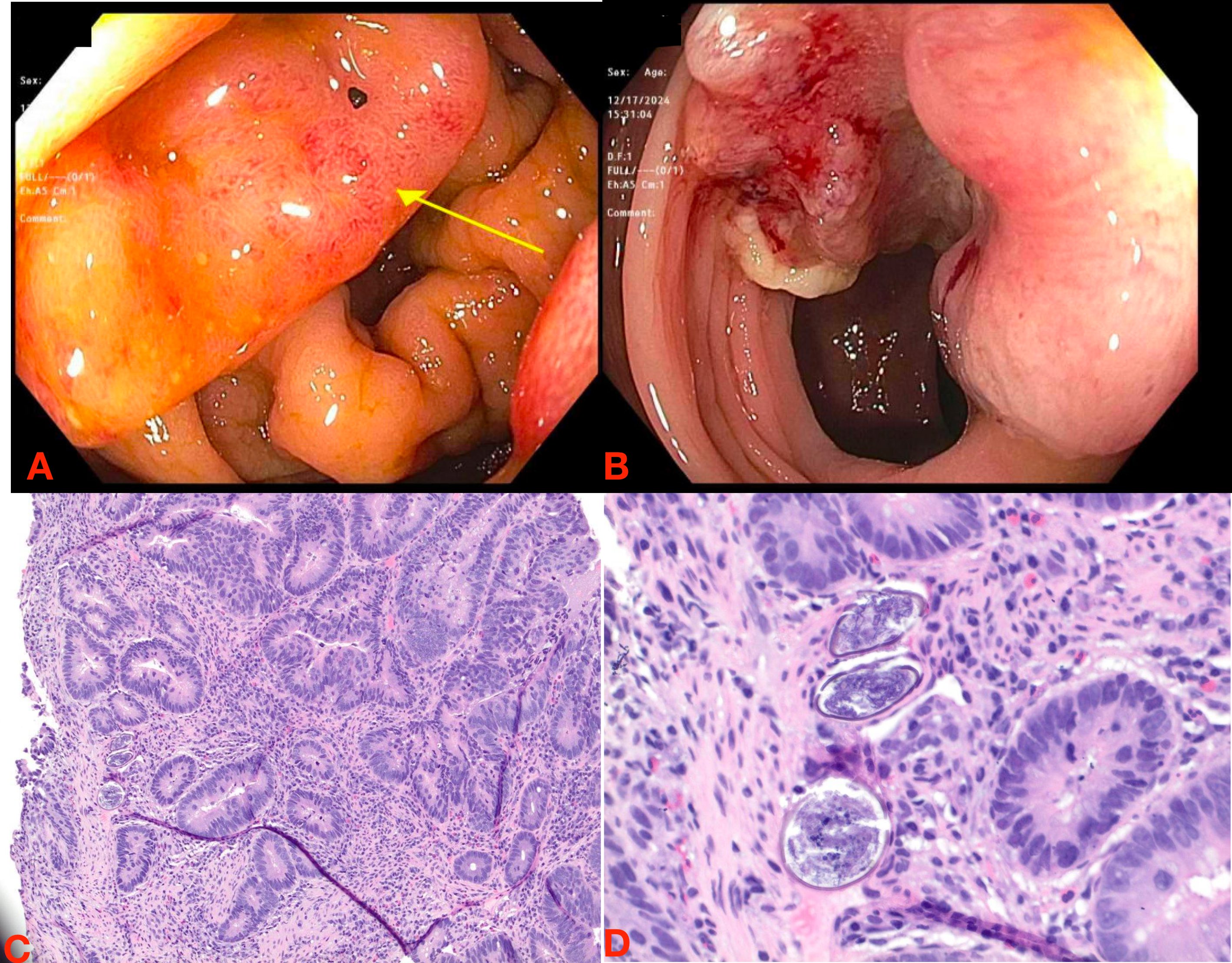Sunday Poster Session
Category: Colon
P0428 - The Hidden Passenger: Schistosomiasis as a Silent Contributor in Colorectal Neoplasia

Vanessa Garcia, BS (she/her/hers)
The Warren Alpert Medical School of Brown University
Providence, RI
Presenting Author(s)
1The Warren Alpert Medical School of Brown University, Providence, RI; 2Brown University / Rhode Island Hospital, Providence, RI
Introduction:
Intestinal schistosomiasis presents with varied manifestations depending on the phase of infection. Affecting around 250 million people globally, it is linked to over half a million deaths yearly. However, reports of colorectal (CRC) cancer associated with active infection are rare. We present a case of invasive sigmoid adenocarcinoma during endoscopic evaluation in a patient with concurrent schistosomiasis.
Case Description/
Methods:
A 63-year-old Cambodian man with history significant for alcohol use disorder and iron deficiency anemia presented with acute onset diarrhea alongside hematochezia and acute on chronic anemia. Colonoscopy revealed multiple polyploid areas in the cecum, nodular mucosa at the ileocecal valve, and a partially obstructing tumor in the sigmoid colon. A biopsy of the ileocecal valve revealed mild active colitis with increased crypt epithelial apoptosis alongside helminth eggs, consistent with schistosomiasis. Biopsy of the sigmoid colon mass revealed moderately differentiated invasive adenocarcinoma. Imaging showed hepatic and peritoneal metastasis. He was treated with praziquantel for two separate 3 day courses over 3 months as well as ivermectin due to concern for concomitant Strongyloides infection. He is currently undergoing chemotherapy.
Discussion: Schistosomiasis infection presents with a wide spectrum of severity, most commonly affecting the sigmoid colon and rectum in the intestine. While some individuals remain asymptomatic others may present with abdominal pain, a change in bowel habits and intestinal bleeding. In more severe cases, complications such as bowel strictures, perforation or malignancy, can occur. Although S. japonicum has been implicated as a possible carcinogen, no definitive causal relationship has been established. The pathogenesis remains under investigation, but chronic inflammation induced by schistosomal toxins is thought to lead to immune dysregulation and progression to malignancy. Increased risk of KRAS mutations and p53 mutations may lead to higher rate of tumor progression as compared to sporadic CRC cancers. Within the literature one study has shown that the 5-year survival rate amongst patients with CRC cancer with concomitant schistosomiasis is around 45.6% compared to 50.9% of non-infected patients with further studies supporting this finding. These findings highlight the importance of recognizing patients at increased risk and underscore the need for further research evaluating association between schistosomiasis and CRC cancer.
Figure: A.) Ileocecal valve view in colonoscopy, yellow arrow denotes nodular mucosa B.) Villous, infiltrative, and ulcerated mass found in the sigmoid colon C.) Low powered view of sigmoid colon mass demonstrating invasive focus with desmoplastic reaction and dysmorphic glands D.) High powered view of sigmoid mass demonstrating helminth eggs consistent with schistosomiasis
Disclosures:
Vanessa Garcia indicated no relevant financial relationships.
Suvithan Rajadurai indicated no relevant financial relationships.
Daniel Kats indicated no relevant financial relationships.
Banreet Dhindsa indicated no relevant financial relationships.
Fazilet Yilmaz indicated no relevant financial relationships.
Vanessa Garcia, BS1, Suvithan Rajadurai, MD2, Daniel Kats, MD2, Banreet Dhindsa, MD2, Fazilet Yilmaz, MD2. P0428 - The Hidden Passenger: Schistosomiasis as a Silent Contributor in Colorectal Neoplasia, ACG 2025 Annual Scientific Meeting Abstracts. Phoenix, AZ: American College of Gastroenterology.

